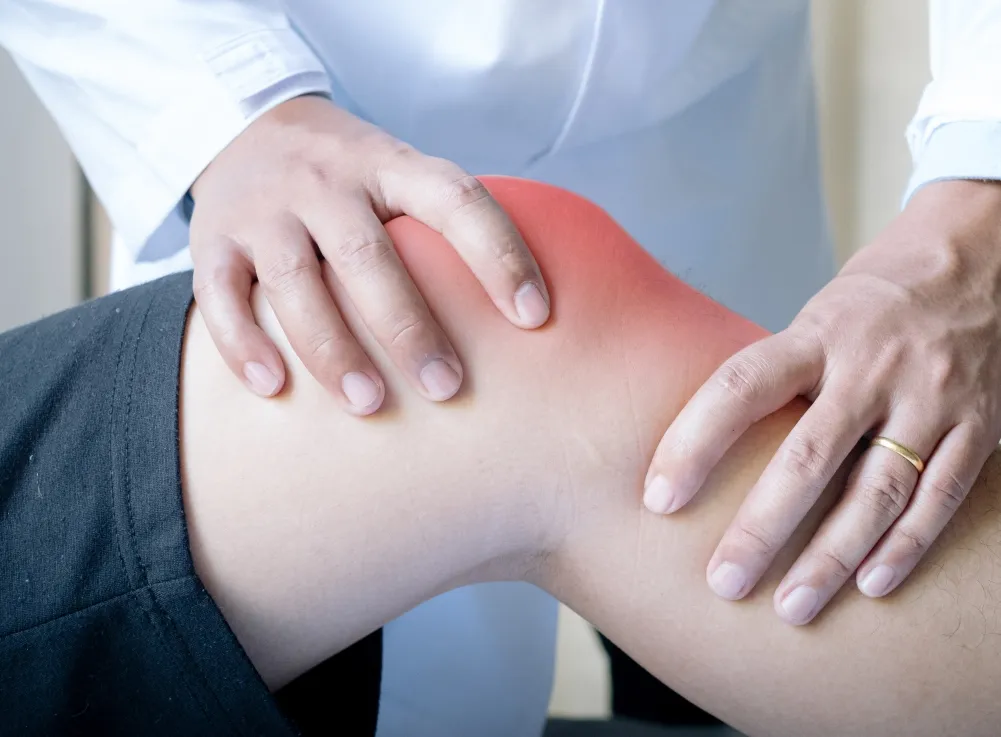Knee pain is a common complaint that affects people of all ages. Knee pain may be the result of an injury, such as a ruptured ligament or torn cartilage. Medical conditions (including arthritis, gout and infections) can also cause knee pain. The symptoms associated with knee pain may include:
- Severe pain and inability to bear weight.
- Swelling around the knee joint.
- Inability to fully extend or flex the knee.
- Any obvious deformities of the knee or the leg.
- Fever along with symptoms like pain, redness and swelling around the knee joint
The location and intensity of knee pain varies depending on the structure involved and can vary from minor dull aching to severe pain. Some underlying conditions related to knee pain are:
- Osteoarthritis: Osteoarthritis is the inflammation or loss of cartilage in the joints caused due to wear and tear. Symptoms include pain and stiffness in the joints, swelling, warm and tender joints and limited movement of affected joints. stiffness in the knee is more in the morning or when you have been sitting for a while. Knee produces a creaking, crackly sound on moving.
- Iliotibial band syndrome: Iliotibial band syndrome (ITBS or IT band syndrome) is an overuse injury of the connective tissues that are located on the lateral or outer part of thigh and knee. ITBS symptoms range from a stinging sensation just above the knee and outside of the knee (lateral side of the knee) joint, to swelling or thickening of the tissue in the area where the band moves over the femur. It is often caused by repetitively bending the knee during physical activities, such as running, cycling, swimming, and climbing.
- Chondromalacia patella: Chondromalacia patella (also known as CMP) is an inflammation of the underside of the kneecap (patella) and softening of the cartilage leading to pain and swelling. The cartilage under the kneecap is a natural shock absorber, and overuse, injury and many other factors can cause increased deterioration and breakdown of the cartilage.
- Runner’s knee: Runner’s knee is the common term used to describe any one of several conditions that cause pain around the kneecap. These conditions include anterior knee pain syndrome, patellofemoral malalignment, chondromalacia patella, and iliotibial (IT) band syndrome. As the name suggests, running is a common cause of runner’s knee, but any activity that repeatedly stresses the knee joint can cause the disorder. This can include walking, skiing, biking, jumping, cycling, and playing sports like soccer.
- Bursitis: Knee bursitis is inflammation of a small fluid-filled sac (bursa) situated near your knee joint. Bursae reduce friction and cushion pressure points between your bones and the tendons, muscles and skin near your joints. Any of the bursa in your knee can become inflamed, but knee bursitis most commonly occurs over the kneecap or on the inner side of your knee below the joint. Knee bursitis causes pain and can limit your mobility.
- Tendinitis: Patellar tendinitis, also known as jumper’s knee, occurs due to overuse injury of the tendon that straightens the knee. Symptoms include pain in the front of the knee. Typically the pain and tenderness is at the lower part of the kneecap, though the upper part may also be affected.
- Meniscal tear: The meniscus is a piece of cartilage that provides a cushion between your femur (thighbone) and tibia (shinbone). There are two menisci in each knee joint. They can be damaged or torn during activities that put pressure on or rotate the knee joint thus leading to knee pain.
- Ligament tear: Tear in ligaments in the knee is a most common sports injuries. The most commonly injured ligament is the anterior cruciate ligament (ACL). Injury can also occur in posterior cruciate ligament (PCL), medial collateral ligament (MCL), and lateral collateral ligament.
At Vivacare Advanced Physiotherapy and Pain Clinic, our physiotherapist will assess the cause of the knee pain and advice you with individualized treatment plan. The clinic provides following therapies to bring you quick and long term relief from knee pain.
- IFT
- TENS
- Ultrasonic Therapy
- PEMF (Pulsed Electromagnetic Field Therapy)
- Kinesiology Taping
- Heat and cold Therapy
- Matrix Rhythm Therapy
- Manual Therapy
- Theraband Stretches
- Posture Therapy
To prevent recurrence of the pain you will be given home exercise regime which will include strengthening and stretching exercises for the muscles around the knees.

